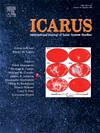Dimension-ratio-based observability analysis of asteroid photometric model and optimization strategy for completely observable satellite detection
IF 2.5
2区 物理与天体物理
Q2 ASTRONOMY & ASTROPHYSICS
引用次数: 0
Abstract
The physical parameters of asteroids are obtained through the inversion of the asteroid photometric model. However, due to limitations in observation orientation, asteroid lightcurves exhibit insensitivity to certain errors in physical parameters. This insensitivity leads to multiple virtual solutions when inverting the asteroid photometric model. To theoretically evaluate the performance of this inversion, we propose a dimension-ratio-based observability analysis of the asteroid photometric model. Firstly, we employ the traditional observability analysis method to generate candidate vectors representing errors in physical parameters. Subsequently, we select unobservable vectors corresponding to very small chi-square values from these candidate vectors. The unobservable vectors span into an unobservable subspace, meaning that large errors within this unobservable subspace result in minimal disturbances in lightcurves, indicating low estimation accuracy for this unobservable subspace. Finally, the dimension-ratio, which is the ratio of the dimension of unobservable subspace to the total number of physical parameters, is used for the observability degree. Building upon this, in response to the issue that ground-based detection hardly acquires completely observable physical parameters, we propose an optimization strategy for completely observable satellite detection, utilizing the hippopotamus optimization algorithm to optimize the satellite orbit. In this optimized orbit, the physical parameters of the asteroid become completely observable. Simulation results demonstrate that the distribution of virtual solutions is consistent with our theoretical analysis. Furthermore, a unique solution available for estimating the physical parameters of the asteroid exists in the optimized satellite orbit.
基于维数比的小行星光度模型可观测性分析及完全可观测卫星探测优化策略
通过对小行星光度模型的反演,获得了小行星的物理参数。然而,由于观测方向的限制,小行星光曲线对某些物理参数的误差不敏感。这种不敏感导致在反演小行星光度模型时产生多个虚拟解。为了从理论上评估这种反演的性能,我们提出了一种基于维度比的小行星光度模型的可观测性分析。首先,采用传统的可观测性分析方法生成表征物理参数误差的候选向量。随后,我们从这些候选向量中选择对应于非常小的卡方值的不可观测向量。不可观测向量跨越到一个不可观测子空间,这意味着在这个不可观测子空间中的大误差导致光曲线的最小干扰,表明这个不可观测子空间的估计精度低。最后,用不可观测子空间的维数与物理参数总数之比来表示可观测度。在此基础上,针对地面探测难以获得完全可观测物理参数的问题,提出了一种完全可观测卫星探测的优化策略,利用河马优化算法对卫星轨道进行优化。在这个优化的轨道上,小行星的物理参数完全可以观察到。仿真结果表明,虚拟解的分布与理论分析一致。此外,在优化的卫星轨道上,存在一个唯一的解来估计小行星的物理参数。
本文章由计算机程序翻译,如有差异,请以英文原文为准。
求助全文
约1分钟内获得全文
求助全文
来源期刊

Icarus
地学天文-天文与天体物理
CiteScore
6.30
自引率
18.80%
发文量
356
审稿时长
2-4 weeks
期刊介绍:
Icarus is devoted to the publication of original contributions in the field of Solar System studies. Manuscripts reporting the results of new research - observational, experimental, or theoretical - concerning the astronomy, geology, meteorology, physics, chemistry, biology, and other scientific aspects of our Solar System or extrasolar systems are welcome. The journal generally does not publish papers devoted exclusively to the Sun, the Earth, celestial mechanics, meteoritics, or astrophysics. Icarus does not publish papers that provide "improved" versions of Bode''s law, or other numerical relations, without a sound physical basis. Icarus does not publish meeting announcements or general notices. Reviews, historical papers, and manuscripts describing spacecraft instrumentation may be considered, but only with prior approval of the editor. An entire issue of the journal is occasionally devoted to a single subject, usually arising from a conference on the same topic. The language of publication is English. American or British usage is accepted, but not a mixture of these.
 求助内容:
求助内容: 应助结果提醒方式:
应助结果提醒方式:


